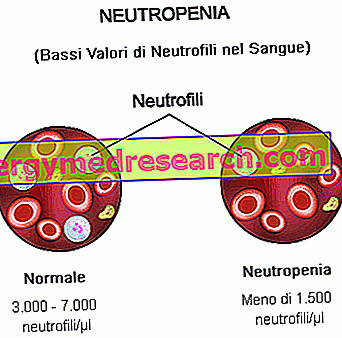Generality
Neutropenia is a reduction in the number of neutrophilic granulocytes circulating in the blood. If severe, this condition increases susceptibility to infection.

There are also forms of neutropenia with a family character (associated with genetic alterations) and idiopathic (whose cause is not known).
Neutropenia usually remains asymptomatic until an infectious state develops. The resulting manifestations may vary, but fever is always present during the most serious infections.
The diagnosis is made through the evaluation of the blood count with leukocyte formula; however, it is also important to identify the root cause, in order to correct the situation where possible and establish the most appropriate treatment.
In the presence of marked neutropenia, it is necessary to immediately start a broad-spectrum empirical antibiotic therapy.
Treatment may also include the administration of granulocyte colony stimulating factor (G-CSF) and the adoption of support measures.
What are neutrophils?
Neutrophils constitute 50-80% of the leukocyte population (set of white blood cells present in the blood).
Under physiological conditions, these immune cells play a crucial role in the body's defense mechanisms against foreign agents, especially infectious ones.
Neutrophils are capable of operating phagocytosis, ie they absorb and digest microorganisms and anomalous particles present in the blood and tissues. Their functions are perfectly linked and integrated with those of the monocyte-macrophage system and lymphocytes.
The adult subject's blood normally contains between 3, 000 and 7, 000 neutrophils per microliter. The organ that produces these cells is the bone marrow, where the stem cells proliferate and differentiate into morphologically recognizable elements like myeloblasts. Through a series of maturation processes, these become granulocytes (thus defined for the presence in their cytoplasm of vesicles containing enzymatic complexes organized in well-evident granules).
The newly formed neutrophils circulate in the blood for 7-10 hours, to migrate into tissues, where they live only for a few days.
Risk of infections
The minimum value of neutrophilic granulocytes considered normal is equal to 1, 500 per microlitre of blood (1.5 x 109 / l).
The severity of neutropenia is directly related to the relative risk of infections, which is greater the more the number of neutrophils per microliter approaches zero.
Neutropenia depends, in any case, on the absolute neutrophil count, defined by multiplying the number of total white blood cells by the percentage of neutrophils and their precursors.
Based on the value thus calculated, it is possible to subdivide the neutropenias into:
- Mild (neutrophils = 1, 000 to 1, 500 / microliter of blood);
- Moderate (neutrophils = 500 to 1, 000 / microlitre);
- Serious (neutrophils <500 / microlitre);
When the count decreases to values lower than 500 / microlitre, the endogenous microbial flora (such as that present in the oral cavity or intestinal level) can cause infections.
If the value of neutrophils decreases beyond 200 / microlitre, the inflammatory response could be inefficient or absent.
The most extreme form of neutropenia is called agranulocytosis .
Causes
Neutropenia may depend on the following physiopathological mechanisms:
- Neutrophil granulocyte production defect : it can be the expression of a nutritional deficiency (eg vitamin B12) or a neoplastic orientation of the hematopoietic stem cell (eg myelodysplasia and acute leukemia).
Furthermore, the lack or reduced production of neutrophils can be the effect of genetic alterations (as happens in the context of different congenital syndromes), damage to the stem cell (medullary aplasia) or replacement of hematopoietic tissue by neoplastic cells ( eg lymphoproliferative diseases or solid tumors).
- Abnorme distribution : it can occur due to excessive seizure in the spleen of circulating neutrophils; a typical example is the hypersplenism characteristic of chronic liver diseases.
- Reduced survival due to increased destruction or increased utilization : marginalization in tissues and neutrophil sequestration recognizes the genesis of various kinds (eg drugs, viral infections, idiopathic, autoimmune diseases, etc.).
Acute and chronic neutropenia
Neutropenia can be of short or long duration.
- Acute neutropenia occurs within a period of a few hours or a few days; this form develops mainly when the use of neutrophils is rapid and their production is lacking.
- Chronic neutropenia lasts for months or years and generally results from reduced production or excessive splenic neutrophil sequestration.
Classification
Neutropenias can be divided into:
- Neutropenias due to intrinsic defects of myeloid cells or their precursors;
- Neutropenias from acquired causes (ie due to extrinsic factors to myeloid progenitors).
Classification of neutropenia | |
Neutropenia from intrinsic defects |
|
Acquired neutropenia |
|
Neutropenias from intrinsic defects
Neutropenia from intrinsic defects of myeloid cells or their precursors is a rare form, but, when present, the most common causes include:
- Idiopathic chronic neutropenia : a heterogeneous group of rare and little known disorders involving myeloid-oriented stem cells.
- Congenital neutropenia : includes various haematological disorders present from birth, essentially due to defects affecting stem cells and which can occur with a constant granulocytopenia (eg severe congenital neutropenia) or cyclic.
Severe congenital neutropenia (or Kostmann's syndrome) is a genetic disease characterized by a maturation arrest in the bone marrow of the granulocyte series at the promyelocytic stage. This leads to an absolute neutrophil count of less than 200 units per microliter. Kostmann syndrome is associated with the mutation of several genes, including ELA2 which encodes neutrophil elastase (an enzyme released by neutrophils during the inflammatory process).
Familial cyclic neutropenia is a rare congenital granulocytopoietic disorder, usually transmitted with an autosomal dominant pattern, in which episodes of neutropenia are observed at regular intervals of approximately 21 days.
Neutropenia can also result from bone marrow failure, due to rare syndromes (eg hair-cartilage hypoplasia, congenital dyskeratosis, type IB glycogenosis and Shwachman-Diamond syndrome).
Neutropenia is also a significant aspect of myelodysplasia and aplastic anemia and may also be present in dysgammaglobulinemia and paroxysmal nocturnal hemoglobinuria.
Acquired Neutropenias
Acquired neutropenia can result from numerous causes; the most frequent include: use of drugs, infections and marrow infiltrative processes.
Post-infection neutropenia
The infections that cause neutropenia are more frequently those viral, in particular varicella, rubella, measles, mononucleosis, flu, cytomegalovirus, Kawasaki disease and hepatitis A, B and C.
Mechanisms can impair production, distribution or survival (by inducing immune-mediated destruction or rapid use) of neutrophils. Furthermore, viruses can induce the formation of antibodies and cause chronic immune neutropenia.
Other infections that can cause a moderate reduction in circulating neutrophils are those from Staphylococcus aureus, brucellosis, tularemia, rickettsiosi and tuberculosis.
Medicinal neutropenia
Drug induced is one of the most frequent forms of neutropenia.
Some medicines can decrease production or increase the destruction of neutrophils, through direct inhibition and / or antibody mediated by bone marrow precursors or peripheral granulocytes. Certain drugs can also produce hypersensitivity reactions.
In some cases, neutropenia can be dose-dependent, especially when therapeutic protocols are established that suppress bone marrow activity.
Among the drugs that can induce neutropenia include antiblastic (anthracycline cyclophosphamide and methotrexate etoposide), antibiotics (penicillamine, cafalosporine and chloramphenicol) antiarrhythmics (amiodarone, procainamide and tocainide), antiepileptics (carbamazepine and phenylidantoin), phenothiazines (chlorpromazine and promazine) and ACE- inhibitors (captopril and enalapril).
Neutropenia due to bone marrow infiltration
Bone marrow infiltration by leukemia, myeloma, lymphoma or solid metastatic tumors (such as those of the breast or prostate) can compromise the production of neutrophils.
Autoimmune neutropenia
Autoimmune neutropenias can be acute, chronic or episodic. These may depend on the production of antibodies against circulating neutrophils or their precursors.
Most patients with this form of neutropenia have an underlying autoimmune or lymphoproliferative disease (eg SLE and Felty syndrome).
Other causes
- Neutropenia due to ineffective production by the bone marrow may occur during anemia caused by vitamin B12 or folate deficiency.
- Alcohol may contribute to neutropenia by inhibiting the medulla neutrophil response in some infections.
- Neutropenia can be observed in association with ketoacidosis in subjects with hyperglycemia.
- Hypersplenism secondary to any cause can lead to modest neutropenia.
Symptoms
Neutropenia itself does not cause any symptoms, but increases the risk and severity of contracting infections, especially bacterial and fungal infections; this predisposition is closely related to the causes, degree and duration of the condition.
Fever is often the only indication of an ongoing infection.
The patient with neutropenia may suffer from otitis media, tonsillitis, pharyngitis, stomatitis, gingivitis, perianal inflammation, colitis, sinusitis, paronychia and skin rash. These infectious complications are often dangerous for subjects who have an impaired immune system, as severe fatal rapidly developing septicemia can occur.
The integrity of skin and mucous membranes, tissue vasculature and the patient's nutritional status also influence the risk of infections; the most common bacteria involved are coagulase-negative staphylococci and Staphylococcus aureus .
Patients with prolonged neutropenia after a bone marrow or chemotherapy transplant, and subjects treated with high doses of corticosteroids, are more prone to fungal infections.
Diagnosis
The clinical presentation allows an initial diagnostic orientation: neutropenia should be suspected in subjects who have frequent, severe or atypical infections, especially if considered at risk (eg patients on cytotoxic drugs).
The confirmation is given by the blood count with leukocyte formula (or emogram), a simple blood test that allows the determination of the percentage of the various cell types of leukocytes (white blood cells) present in the peripheral blood smear.
Commonly, the diagnosis of neutropenia arises when the absolute number of neutrophil granulocytes is less than 1, 500 per microlitre of blood (1.5 x 109 / l). The observation of the peripheral blood smear also allows a first pathogenetic classification, which will then be deepened through histological and cytological examination of the bone marrow.
To check if an infection is present, laboratory investigations should be performed quickly. For evaluation purposes, blood cultures, urinalysis and imaging studies (chest X-ray, CT of the paranasal sinuses and abdomen, etc.) are required.
Subsequently, the mechanism and the cause of neutropenia must be determined to establish the most appropriate treatment. The anamnesis is intended to ascertain medication intake and possible exposure to toxins. On the other hand, the physical examination should assess the presence of splenomegaly and signs of other occult disorders (eg arthritis or lymphadenopathy).
The study of the sample of bone marrow aspirate or bone marrow biopsy allows to establish if neutropenia is due to a reduced production or if it is secondary to an increased destruction or use of granulocytes. Cytogenetic analysis and immunophenotypic studies on hematopoietic cord can also help to identify the specific cause (eg aplastic anemia, myelofibrosis and leukemia).
The choice of further investigations is determined by the duration and severity of neutropenia and the results of the physical examination.
Treatment
In the presence of severe neutropenia, the timely administration of a broad-spectrum empirical antibiotic therapy is required. Antifungal therapy (eg azoles, echinocandins or polyenes) should be added if the fever persists 4 days after the application of the antibiotic regimen.
The treatment must then be adapted based on the results of the cultures and the antibiogram, due to the risk of selection of resistant microorganisms.
Antibiotic / antifungal therapy may be associated with the use of myeloid growth factors - such as G-CSF (granulocyte colony stimulating factor) or GM-CSF (granulocyte-macrophage colony stimulating factor) - which favor the differentiation of neutrophil precursors and activate mobilization in the bone marrow of stem cells.
Sometimes vitamins, immunoglobulins, immunosuppressive drugs, corticosteroids and granulocyte transfusions can be used to influence the production, distribution and destruction of neutrophils.



